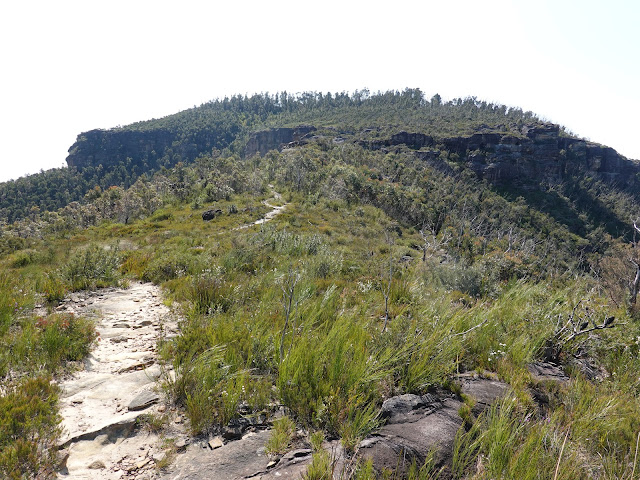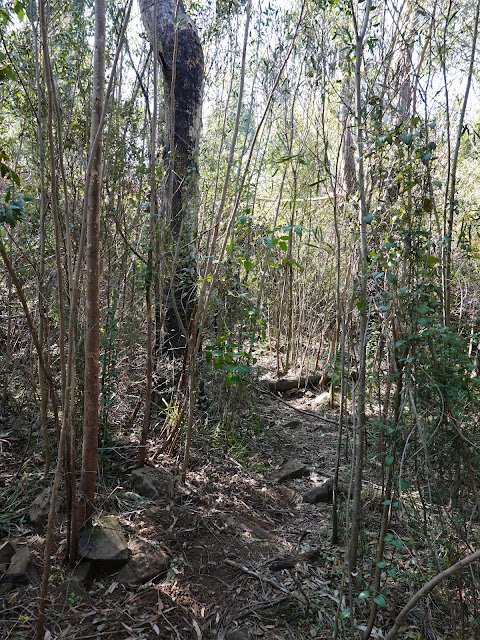Butterbox Point & Mount Hay 14-09-2024
This map was created using GPS Visualizer's do-it-yourself geographic utilities.
Please wait while the map data loads...
Route: Mount Hay Road, Butterbox Track, The Butterbox, Butterbox Point, Butterbox Track, Mount Hay Range, Mount Hay, Butterbox formations, Mount Hay Road
Date: 14/09/2024
From: Mount Hay Road
Parking: Mount Hay Road
Start Point: Mount Hay Road
Finish Point: Mount Hay Road
Region: Blue Mountains
Route length: 7.4 km
Time taken: 02:56
Average speed: 3.7 km/h
Ascent: 338m
Descent: 337m
Points of Interest: The Butterbox, Butterbox Point, Mount Hay, Butterbox formations
Towards the end of Mount Hay Road is Butterbox Point, an awe-inspiring location a little off the beaten track. That's thanks to Mount Hay Road itself, a long, winding unsealed road that spears into the wilder areas of the Blue Mountains. The route is generally passable by 2WD cars (like mine) unless the weather has been poor, as it can open up large potholes that need a high-clearance vehicle. If you time it right by watching the internet, you can pick a time after the road's periodic regrading. It's 12 km along the unsealed road Butterbox Point and should take around half an hour to drive.
There's a small parking area at the trailhead for both the Mount Hay and Butterbox Point tracks. Both can be combined into a single outing, as I have done today; your choice is which to tackle first.
 |
| The parking area at the beginning of the track |
You'll find an information sign at the beginning of the Butterbox/Mount Hay track. This has recently been replaced after being burned in a significant bushfire in 2020. I was last here not long after the fires had been put out, and the area reopened. It's nice to see much of the area has recovered. The hike follows a Y-shaped route, leading east to Mount Hay and west to Butterbox Point, with a small marker post indicating the junction of the two trails. |
| The information board at the beginning of the tracks tells you more about the area. |
I opted to head to Butterbox Point first to make the most of the quiet morning and the favourable light. From the marker post, the path is fairly flat as it passes above Butterbox Swamp, a unique habitat that forms where water becomes trapped in the soil by an underlying layer of clay. It is also the starting point for Butterbox Creek, which carves an exciting route through the sandstone (for experienced adventurers only). |
| Butterbox Track |
 |
| The Pinnacles |
 |
| The crags above Butterbox Swamp |
 |
| Butterbox Swamp |
 |
| Approaching the Butterbox |
The trail ascends a rise and then leads toward a large rock outcrop known as the Butterbox, named for its rectangular shape, which also gives its name to Butterbox Point. The name is attributed to Cyril Byles, a railway engineer from NSW, who explored the Mount Hay area with his daughter long before the road was built. You can take either side of the outcrop, but I prefer to start with the left fork, saving the views of the valley for a little later.
 |
| The Butterbox (or Hay Monolith) |
The path passes a couple of large overhangs, or caves as they are often referred to, and becomes a little rougher as you reach the end of the Butterbox. Ahead you see the towering walls above Butterbox Canyon, but off to the right, the views of the Grose Valley begin to steal the limelight.
 |
| The first of two caves |
 |
| The Butterbox Track approaches the edge of the cliffs |
 |
| Views of the Grose Valley from the cliff edge |
First, there's a flat rock with an uninterrupted view down the valley. It looks like it hangs over a sheer drop, but this is just an illusion. To your left is the immense Walford Wall leading to Du Faur Head, while directly opposite is Edgeworth David Head and Mount Banks, which top the Banks Wall. Off to the right is the continuation of the Grose River as it flows towards the Hawkesbury River several kilometres downstream.
 |
| Grose Valley |
 |
| Butterbox Point |
 |
| Grose River and Edgeworth David Head |
You can continue by climbing down a rocky outcrop and heading towards the prominent point ahead of you. The view of the valley is much the same here, but you'll get a better look at Butterbox Canyon and the Walford Wall. This is as far as I ventured before turning around.
 |
| Butterbox Point |
 |
| Grose Valley panorama |
 |
| Continuing along the Grose Valley |
 |
| Walford Walls |
 |
| Butterbox Canyon |
 |
| Grose Valley |
 |
| Grose Valley |
Following the trail back to the Butterbox, you'll find some paths branching off to the left. These pass around the north side of the Butterbox, perched on the top of the cliffs. If the weather is bad, you should avoid the path because it is exposed for a short distance. Once past this point, you can also opt to clamber atop the Butterbox for more views across the area. |
| Below the Butterbox |
 |
| More views from the edge of the cliff |
 |
| Grose River and Edgeworth David Head |
 |
| The path on the north side of the Butterbox |
 |
| The many pats around Butterbox Point |
 |
| Butterbox Point and the Walford Wall |
 |
| Mount Hay |
The path heads along a broad ridge with expansive views to the east, over the swampy birthplace of Mount Hay Creek as far as the gleaming towers of Parramatta and Sydney on a clear day. Heading towards Mount Hay leads to the bottom of a rocky spur and the start of some more interesting, occasionally hands-on hiking.
 |
| The path picks its way around the head of this small valley |
 |
| The path towards Mount Hay can be clearly followed |
 |
| Mount Hay |
While the path can be a bit indistinct at times, route finding is relatively straightforward—head up through the rocks and avoid any places that look too steep. As you climb, the spur offers tremendous views of the Grose Valley.
 |
| Climbing Mount Hay |
 |
| The change in vegetation is obvious as you near the summit |
Passing an informal lookout leads to the last section of the climb, entering the trees which dominate the summit of the hill. Unlike the surrounding sandstone, Mount Hay is capped by basalt which creates a more fertile environment for different plant species, hence the lush covering at the summit. Weaving through the trees leads to a cairn at the highest point. Sadly, there are no views to be had from the summit of Mount Hay thanks to the covering of trees.
 |
| The summit of Mount Hay |
As the age-old saying goes, what goes up, must come down, and I retraced the route from Mount Hay's summit back to the marker post near the car park.
 |
| Views from the descent off Mount Hay |
 |
| Mount Hay |
 |
| The Grose Valley |
 |
| The western slopes of Mount Hay |
 |
| A distant Sydney |
 |
| The path back towards the car park |
 |
| The Butterbox |
 |
| Mount Hay Track |
There was one final objective on my mind, having made it back to the car park. I had read about the strange rock formations that can be found in the area and was expecting to stumble across while I was at Butterbox Point, but there was no sign of them. After a quick internet search, I found their location and set off to find, them.
There's a path that goes off to the left away from the edge of the cliffs and back to Butterbox Swamp. Almost immediately, you find the first of many bizarrely shaped rocks.
The rocks have been formed through two processes. First, the formation of concentric ironstone patterns called Liesegang rings. These are believed to have been formed from the precipitation of insoluble haematite from soluble iron in groundwater. Second, the hard and resistant haematite ironstone has been exposed during weathering, leaving the distinct ribbed rock behind.
 |
| Butterbox formation |
 |
| Butterbox formation |
 |
| Butterbox formation |
 |
| Butterbox formation |
 |
| Butterbox formation |
After wandering around for a bit, I decided it was finally time to return to the car park properly this time and start making tracks back to Sydney. As ever, this was a sensational day in the mountains thanks to the superb weather and the equally superb views. If you can face the challenge of Mount Hay Road, this should be high on your list of places to visit.
















































No comments :
Post a Comment